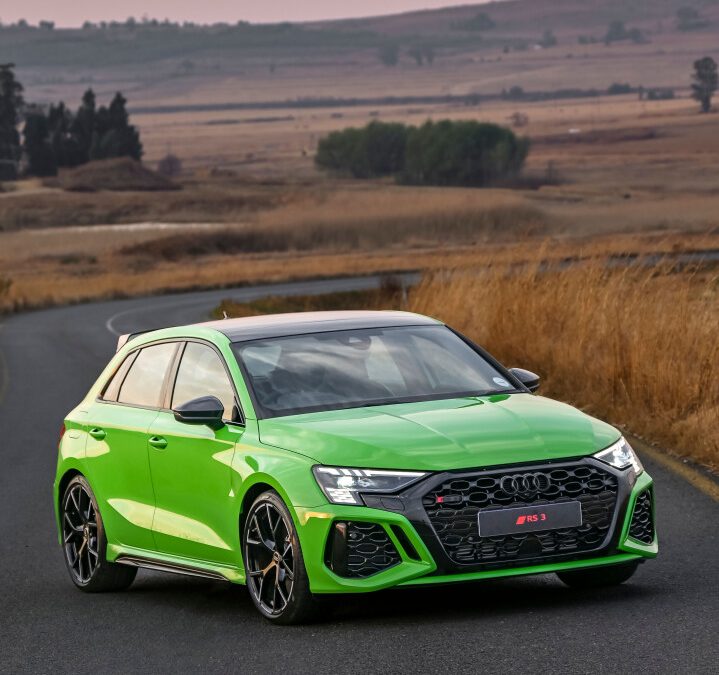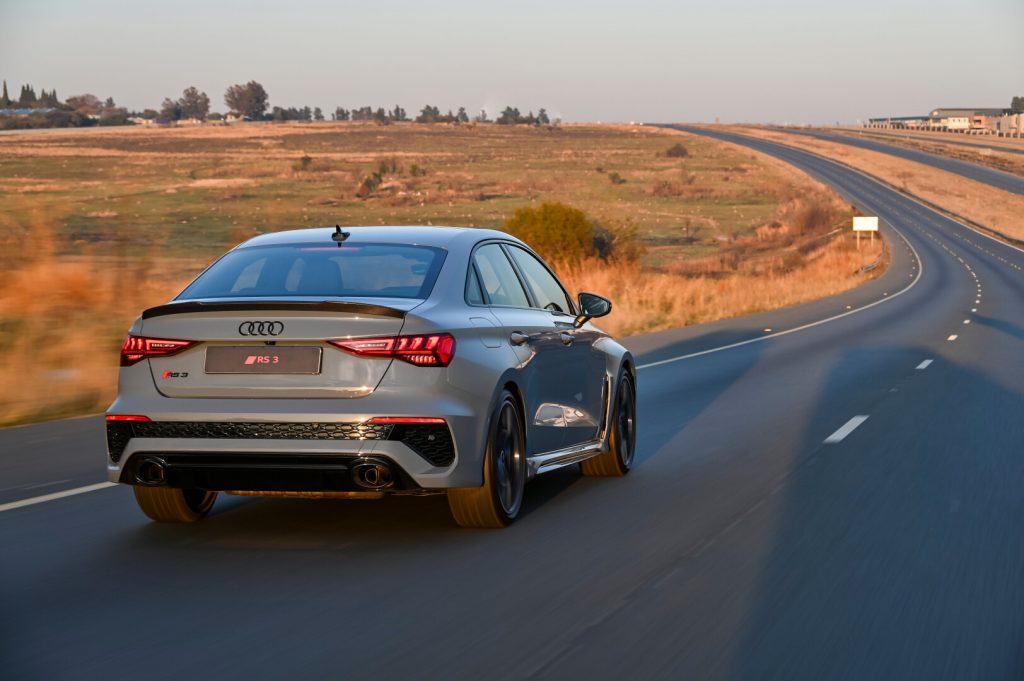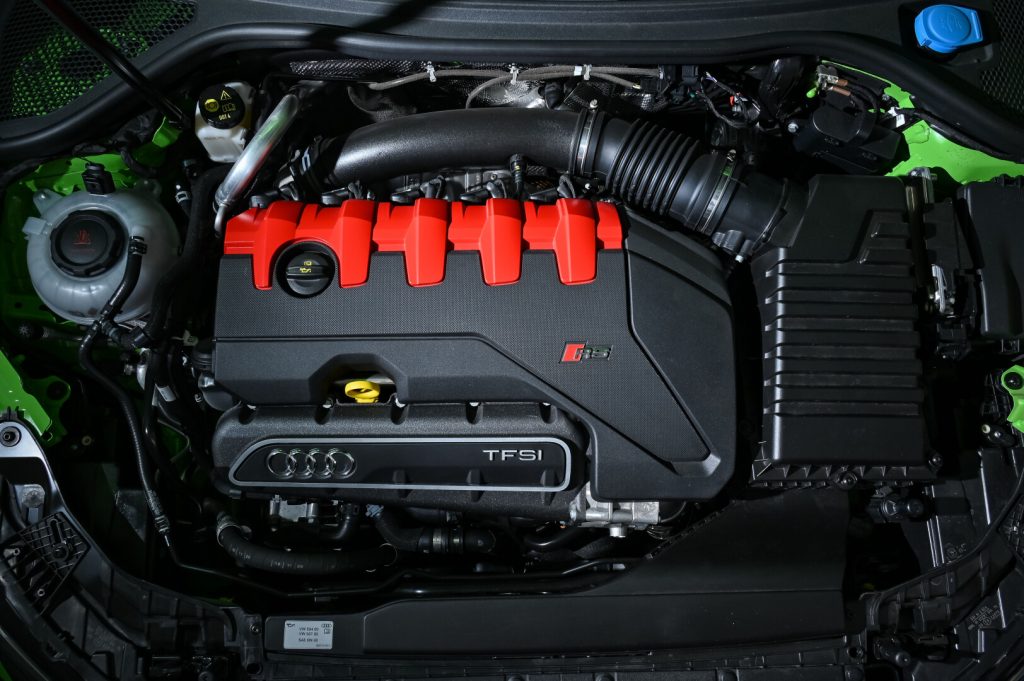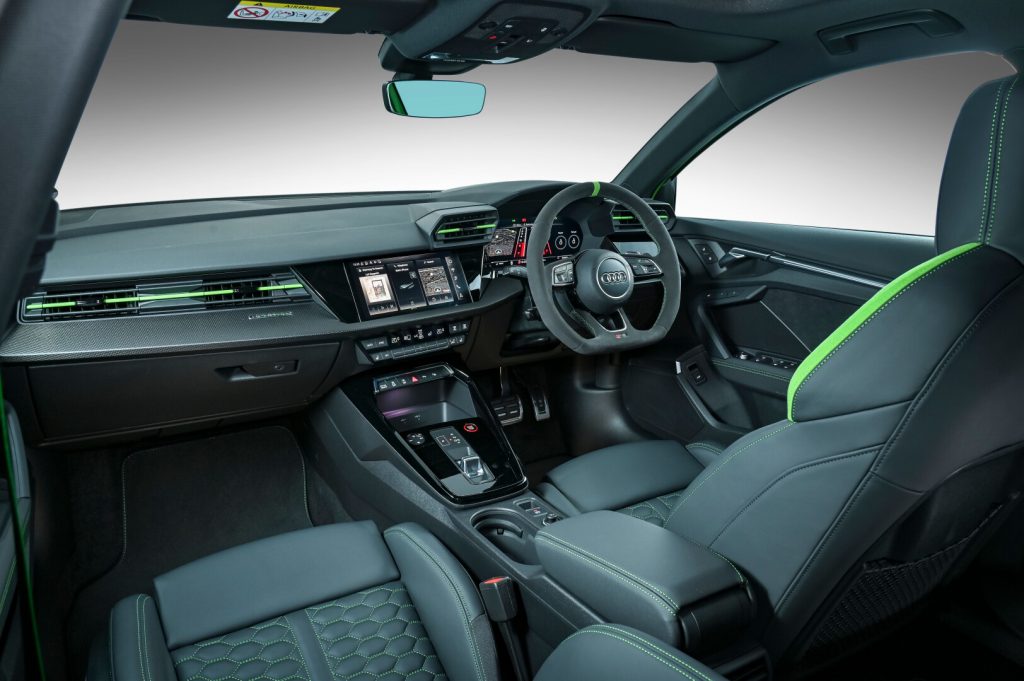With the third generation of the Audi RS 3 Sportback and the second generation of the RS 3 Sedan, Audi is relaunching the sporty top-of-the-line pair in the compact high-performance segment. The award-winning five-cylinder engine now has more torque, making it even more powerful. In combination with the RS torque splitter installed for the first time in an Audi, the A3 series’ emotional flagship model offers performance and lateral dynamics on a whole new level. Local market introduction of the RS 3 model range takes place today with prices starting at R1,215,000 for the RS 3 Sportback and R1,245,000 for the RS 3 Sedan (inclusive of VAT and all taxes).
The 2.5 TFSI: unmatched acceleration and top speed
With its five-cylinder, high-performance engine, the Audi RS 3 is one-of-a-kind in its segment. The 2.5 TFSI has won the “International Engine of the Year” award nine times in a row. In the latest generation of the compact sports car, the engine is now more powerful than ever before. This is mainly due to the increased torque of 500 Newton metres – 20 Newton metres more than in the predecessor. It ranges from 2,250 and 5,600 rpm. The new RS 3 models reach the broad power plateau, which extends to 7,000 rpm, from as low as 5,600 rpm. Boasting 294 kW of power, they sprint from 0 to 100 km/h in 3.8 seconds thanks to Launch Control – three tenths of a second faster than before. The models’ top speed, which is electronically limited to 250 km/h, can be optionally increased to 290 km/h (if the RS Dynamic package Plus is selected) – just like acceleration, this is an unmatched figure in the compact segment. In the NEDC combined cycle, the RS 3 Sedan and RS 3 Sportback consumes 9.0 litres of fuel per 100 kilometres on average.
The impressive propulsion of the multiple award-winning five-cylinder engine is appropriately orchestrated by a new exhaust system. For the first time in an RS 3, it features a fully variable flap control system that supports intermediate positions, thus broadening the sound characteristics even further. The differences can be experienced in the various modes offered by the Audi drive select dynamic handling system. In the dynamic and RS Performance modes, for example, the flaps open much earlier – the electrifying elements of the sound are even more pronounced. The standard RS sports exhaust system brings out the unmistakable sound of the five-cylinder engine even more clearly.
RS torque splitter and specific RS 3 modes for maximum agility
The RS torque splitter, installed for the first time in an Audi, makes the driving experience even more exhilarating and provides a dynamic balance. It replaces the previous rear axle differential with an upstream multiple disc clutch package. Instead, an electronically controlled multiple disc clutch is used on each of the drive shafts that distributes torque between the rear wheels in a fully variable manner. This results in even greater stability and agility. During dynamic driving, the torque splitter increases torque delivered to the outer rear wheel with the higher wheel load, which significantly reduces the tendency to understeer. In left-hand curves, it transmits the drive torque to the right rear wheel, in right-hand curves to the left rear wheel, and when driving straight ahead, to both wheels. The difference in propulsive forces means that the new RS 3 turns into curves even better and follows the steering angle more precisely – especially when cornering at high speeds.
In addition to the torque splitter, Audi drive select also has an effect on the engine and transmission characteristics, steering assistance, the adaptive dampers, and the exhaust flaps. Different characteristic curves for each of the aforementioned systems create a broad range of driving experiences – from an emphasis on comfort and optimized fuel consumption to highly dynamic and even optimized for the racetrack.
The new RS Performance mode specific to the RS 3, is designed specifically for the racetrack with its own engine and transmission setup and specially calibrated to the Pirelli P Zero “Trofeo R” semi-slick tyres, which are optionally available from order for the first time. There, the torque splitter ensures the most neutral handling possible with little oversteering or understeering in different driving situations. This makes early acceleration possible upon exiting a curve, enabling faster lap times. Another new addition is the RS Torque Rear mode, which makes drifting possible. It is designed for use on closed roads. In this mode, the torque splitter induces considerable oversteer by transferring all of the rearward drive torque to the wheel on the outside of the curve – up to a maximum of 1,750 newton metres. The models also come with efficiency, comfort, auto, and dynamic modes, as well as RS Individual, which allows the systems to be set individually.
Exterior and lighting: expressive and unmistakable
The design of the new Audi RS 3 is even more dynamic and powerful than that of its predecessor. In the front, the wide RS bumper, the redesigned Singleframe with its distinctive honeycomb grille, and the large air intakes give the compact sports car an expressive appearance. Behind the flared fenders, a slightly protruding air outlet creates a motorsport look. The front axle track has been widened by 33 millimetres. At the rear axle, the new RS 3 Sportback has added ten millimetres.
The RS 3 comes standard-equipped with Matrix LED headlights with darkened bezels that feature digital daytime running lights around their outer downturned angles. LED taillights, including dynamic turn signal lights, door entrance LED lighting with RS logo projection in the front, contour ambient lighting with multi-coloured accents are other exciting standard lighting features as well. The highlight of the RS3 lighting technology is the headlights pixel field of 3 x 5 LED segments, it provides an unmistakable look – when the vehicle is opened, the RS 3 lettering appears on the driver’s side and a checkered flag appears in the pixel field of the other headlight, creating a dynamic scene. When driving, the checkered flag lights up on both sides.
Audi delivers the RS 3 with 19-inch cast wheels in a 10-Y spoke design as standard. True racing design is embodied by the optionally available 5-Y spokes with RS branding. The motorsports-inspired finishing touches include the redesigned RS-specific rear bumper with built-in diffuser and the RS exhaust system with a large oval tailpipe on both the left and right side. Some exterior peripherals (as part of the standard Black Styling Package), such as the mirror caps, the inserts in the rocker panels, and the tailgate and roof edge spoilers, are available in carbon-fiber-reinforced plastic for an even sportier look. Locally, customers can opt for the optional Black Styling Package Plus or the Aluminum Styling Package Plus which enhances the exterior of the car with either additional gloss black or matte aluminum accents. A total of eight exterior colors are available for the models, including the RS-specific Kyalami Green and Kemora Grey finishes.
Driving dynamics made visible: the interior
In the interior, too, many elements specific to the RS accentuate its sportiness. The standard equipped 12.3-inch Audi virtual cockpit plus displays the revolutions per minute in the “RS Runway” design. In this case, the values are displayed in the opposite direction in a manner that visually resembles an airplane runway – the highest number of revolutions in the foreground and the lowest in the background. In addition, the Audi virtual cockpit plus includes displays for g-forces, lap times, and acceleration from 0 – 100 km/h, 0 – 200 km/h, quarter mile, and eighth of a mile.
The RS-specific blinking shift indicator in manual transmission mode changes the rpm display from green to yellow to red, blinking in a manner identical to that used in motorsports, to indicate the ideal time to change gears. It is also integrated into the optional head-up display, which is available for the first time that projects relevant information onto the windshield in the driver’s direct line of sight. The 10.1-inch touch display in the instrument panel also displays the coolant, engine, and transmission oil temperatures, as well as the g-forces and, optionally, the pressure of the tyres.
The expressive look is enhanced by the carbon-fiber trim in the instrument panel and RS sport seats with RS embossing and anthracite contrast stitching. The seat upholstery is optionally available in fine Nappa leather with RS honeycomb stitching and glossy black, red, or, for the first time, green contrast stitching. RS Design packages in red and green are available to match. They include special floor mats with contrast stitching and RS embroidery, as well as seatbelts with matching coloured edges. In the RS design package plus, the seat shoulders, stitching of the seat belt and floor mat as well as the accents around the air vents also come in matching red or green.
Local standard equipment highlights
The Audi RS 3 model range is highly equipped with ideal specification and features which proudly showcase its performance, digital and design points. The following equipment highlights are worth mentioning: Audi RS virtual cockpit; darkened Matrix LED headlights with dynamic light design; Black styling package; Bang & Olufsen premium sound system with 3D sound; Audi smartphone interface; Audi connect e-call functionality; sport seats in front; RS Sports exhaust; rearview camera; park assist; comfort key with safelock; progressive steering and 19-inch wheels (to name a few).
The new Audi RS 3 Sportback and Sedan will officially go on sale in South Africa from 1 September 2022 and and comes standard with a five year Audi Freeway Plan.





